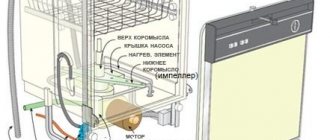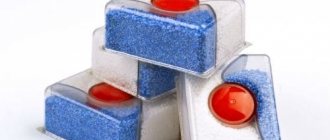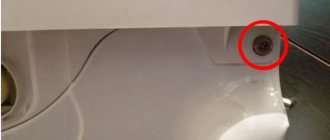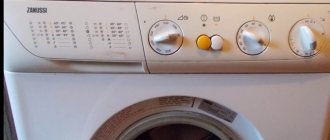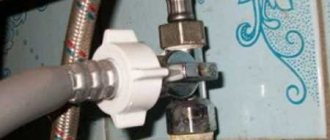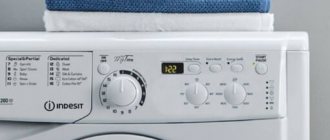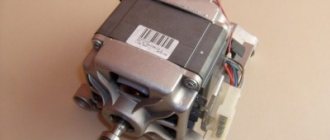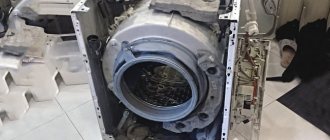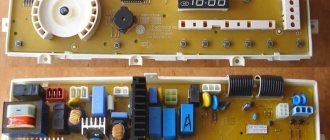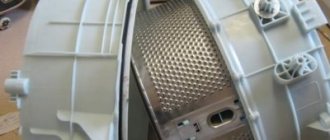A dishwasher is a complex device consisting of mechanical and electronic components. Like any equipment, it is subject to wear and tear. To make a professional repair of a dishwasher with your own hands, you will need to understand the principle of operation of the device, have knowledge of electronics, and be able to read electrical diagrams. But anyone can carry out simple repairs.
Dishwasher device
Regardless of the brand and model, the design of the dishwasher is practically the same. The main nodes include:
- engine;
- circulation block;
- pump;
- pump;
- Control block;
- heating element (heating element);
- pressure switch;
- sensors;
- rocker;
- housing, wiring, hoses, clamps.
Differences between models include optional features and additions. It could be:
- Heat exchanger. Allows you to dry dishes after washing. It looks like a container of water that gives off heat.
- Fan and additional heating element. Designed for drying dishes.
- Turbidity sensor. Measures the clarity of water after rinsing.
- Rinse aid and salt sensor.
- Water hardness sensor. Depending on the hardness value, the consumption of detergents is adjusted.
The machine takes in too much water
In certain cases, the dishwasher may continue to fill with water even after it has been turned off, or may fill with too much liquid before the wash cycle begins. If the machine takes in too much water before washing, the level sensor is probably broken. It is located at the bottom of the unit. Before starting repair work, place the equipment on the floor and replace the water intake sensor.
If the machine draws water even after turning off the power, you can check the solenoid valve responsible for stopping the liquid supply. In this case, making repairs yourself is very easy. Find the valve; it is located where the inlet hose is attached to the unit body. Disconnect the dishwasher from the communications, remove the broken part and install a new valve in its original place.
How the dishwasher works
To repair equipment, it is important to understand how it works. After dishes and detergents are loaded into the device, a program is selected and the start button is pressed, water is supplied . It is supplied through a valve to the water collection hopper using a pump. The water level is controlled by a pressure switch , which sends a signal when the intake is complete. Water under pressure enters the impeller, causing it to rotate. the compartment with detergent opens , and it mixes with jets of water gushing from the impeller nozzles.
Water is heated using a heating element, the heating temperature is controlled by a thermocouple. The water flows into the pan and re-enters the sprayer through the filter.
After the end of the program, the signal from the control unit is sent to the solenoid valve. It shuts off the water supply to the sprinkler and allows access to drain it into the sewer. This starts the pump, pumping water out of the pan. Depending on the program, the cycle is repeated several times. At the end of the work, the water is finally drained and the drying mode . Drying occurs by condensation or by warm blowing on the dishes. After a while, the microprocessor of the device receives a signal indicating the end of the process and the door can be opened.
Basic malfunctions and their elimination
Next, we list the most common defects and tell you how you can eliminate them by doing the repairs yourself. Many of them are associated with external factors, for example, low water pressure in pipes or insufficient voltage in the electrical network. Many malfunctions are associated with blockages in the drainage or drainage system of the PMM. This kind of problem is quite easy to fix on your own.
Dishwasher won't turn on
If such an event occurs, the first thing that comes to mind is that there is no supply voltage . This can happen for various reasons:
- the power cord is not plugged into the outlet or is damaged;
- no contact in the 220 V socket;
- the PMM input network filter has failed;
- The electronic control unit (hereinafter also referred to as ECU) is damaged.
A multimeter is a device that helps check the presence of supply voltage
In order to perform diagnostics and check the presence of supply voltage, the user will need a multimeter (hereinafter also referred to as a tester). This device is universal and can be used in the household for various equipment problems.
Damage to the power cord can lead not only to the shutdown of the PMM, but also to a fire.
The tester will allow you to determine whether there is voltage in the socket, and also check the wiring inside the PMM housing for a break. The surge protector may burn out due to excess voltage in the electrical network. A sign of damage is the presence of burnt elements.
In addition to the filter, a starting capacitor installed on the drain pump can prevent the dishwasher from turning on. The serviceability of the capacitor can also be checked with a multimeter by measuring its resistance. Damaged parts must be replaced with strictly similar ones: you should not experiment with the capacitance and permissible voltage of capacitors.
Damage to the ECU is less likely; such a breakdown is complex and requires qualified intervention. In addition to the above reasons, the source of the problem may be the lack of water in the water supply and the door not being closed until it clicks - in these cases, the operating program does not start.
The dishwasher is leaking
Water leakage in the bottom of the PMM is a fairly common malfunction that can lead to flooding of the room. Therefore, recently, almost all manufacturers have equipped their dishwashers with Aquastop protective systems (hereinafter also referred to as “Aquastop”).
Float and sensor of the Aquastop system located in the bottom of the dishwasher
When water penetrates the bottom of the PMM, it lifts the polystyrene float. He begins to put pressure on the sensor, which triggers and sends a signal to shut off the water. The machine stops working, the liquid at the inlet is blocked by a solenoid valve built into the inlet hose. At the same time, the drain pump starts, which pumps water out of the dishwasher. The display shows an error code, which makes it easy to identify the malfunction.
Aquastop solenoid valve at the inlet hose
There can be several reasons for a leak:
- During installation, the dishwasher was not leveled, so the water overflows over the edge of the tank;
- due to poor-quality detergent or its overdose, excessive foaming is observed;
- the water level sensor (hereinafter also referred to as the pressure switch) is faulty, causing the machine to draw too much liquid;
- the seal of the door is broken due to loss of elasticity of the seal or its loose fit to the body;
- The Aquastop system sensor is faulty or the float is stuck.
Eliminating the above problems, with the exception of replacing the pressure switch and the sensor with a float, is quite simple. The condition of the door and excessive foaming are visible to the naked eye; setting the PMM level is also not difficult. In these cases, it is enough to eliminate the cause, remove the water from the pan, dry the machine, and it will be ready for use again.
In addition to the reasons listed, there is a possibility of a leak in the connection of one of the pipes located in the machine body. Read more about leaks and their elimination here.
From this video, readers can learn what to do if your dishwasher is leaking:
Water does not drain
In this case, you can also fix the dishwasher yourself. Problems with the drainage system can occur for several reasons:
- there is a blockage in the drain hose or it is simply pinched;
- sewer clogged;
- the filter element is clogged because it has not been cleaned for a long time;
- The drain pump does not work.
Owners can solve problems with sewerage themselves or call plumbers for this. The filter must be removed and washed thoroughly in warm water and dishwashing detergent to remove grease from the fine mesh.
Removing the filter from its slot for cleaning
You can check the drain pump impeller for free rotation without disassembling the machine body. Access to it will open if you unscrew the hexagon socket screw (TORX) in the glass under the filter and remove the protective cap. You can then check the rotation with your fingers and remove the foreign object with tweezers if it is interfering with the pump.
Disconnecting the drain hose from the diagnostic pump
To diagnose the drain hose for blockages, you will have to disassemble the dishwasher body to get to its bottom. Otherwise, it cannot be separated from the drain pump. Read more about problems with drainage in PMM here. In addition, readers can watch a video that answers the question of how to unblock the drain pump of a Bosch dishwasher:
Water flows poorly or does not flow at all
This kind of defect is associated with insufficient water pressure or clogging in the PMM inlet filters. The malfunction may be accompanied by poor rinsing. To troubleshoot malfunctions, remove and clean the strainers at the inlet hose inlet and at its connection to the dishwasher body.
Coarse filter in the inlet fitting of the dishwasher housing
The Aquastop solenoid valve at the inlet hose may be faulty. To determine serviceability, it is enough to check the resistance of its winding with a multimeter. If the device shows an open circuit, the valve must be replaced. A working valve should have a resistance of 1.5 to 5 kOhm.
In addition, the intake valve in the PMM itself, which is controlled by the ECU, may fail. Also, the cause of poor fluid collection may be improper operation of the pressure switch, giving incorrect readings about its level.
Filter at the inlet of the Aquastop solenoid valve
From this video, readers will learn how to find out the reason for the lack of water supply:
Poor dishwashing quality
In this case, you need to pay attention to whether you are operating the dishwasher correctly. Most often, it is this factor that affects the quality of washing kitchen utensils. For example, not enough washing gel or powder is loaded, dishes are not placed in baskets correctly.
Incorrect placement of dishes is one of the main reasons for poor washing quality
Another probable reason is the formation of scale on the electric water heater. As a result, the liquid does not heat up to the required temperature, which prevents the proper cleaning of kitchen equipment from dirt and food debris. How to clean PMM and its parts from scale, read here.
The nozzles in the sprinkler rocker arms must be cleaned regularly
Another probable reason for poor washing is contamination of the holes in the rocker arms of the sprayers (nozzles). To clean them, you need to remove the lower and upper sprinklers from the chamber and clean their holes with a toothpick, picking out the dirt out.
In many cases, you can diagnose and repair a dishwasher yourself. It is worth calling a specialist in difficult situations when your own strength has been exhausted. Readers can find more detailed information about all common PMM malfunctions on our website.
Primary fault diagnosis
There are actually not that many malfunctions due to which the dishwasher does not work properly. They are known, and some of them resolve on their own. Very often, breakdowns are associated with the connection of communication devices or with irregularities in the operation of the device.
First of all, you need to make sure that the problem is in the machine itself. The water supply and drainage and the serviceability of the electrical network are checked. To do this, the dishwasher is disconnected from the communication systems, and their serviceability is checked independently of each other. If you suspect a breakdown of the device itself, pay attention to the following factors:
- The presence of extraneous sounds during operation. Most likely, the sprayer or pump bearings have failed. Incorrect loading of dishes.
- Water supply error. The outlet valve or supply hose will need to be replaced; the pressure switch is faulty.
- Stopping the program while running. There is a failure in the control system, you should repeat the launch on another program in a few minutes. Such a breakdown can also be caused by a malfunction of the filter, heating element, disturbances in water intake, or low voltage in the network.
- No heating. There is a high probability of failure of the temperature sensor or heating element, damage to the terminals of the heating element.
- The machine does not start. Damage to the electronics unit, no water supply, front door not closed.
- The device does not drain water. First of all, you need to check the sump pump and the hoses connected to it.
The main reasons why dishwashers fail
In addition to natural wear and tear, there are several other factors that provoke malfunctions in dishwashing machines. These include:
- incorrect installation of the PMM after its purchase;
- violation of the rules for operating this household appliance;
- the water in the tap is too hard;
- instability of the electrical network (surges in supply voltage);
- using low-quality household chemicals to soften water and wash dishes.
Exceeding the dosage or poor quality of the detergent leads to uncontrolled foaming in the PMM
It’s paradoxical, but true: most dishwasher malfunctions occur precisely for the reasons listed above. For example, it is important to comply with the restrictions on the length of communications when installing a dishwasher and to set it clearly at level. All legs must be adjusted to the unevenness of the floor so that during operation there are no vibrations that negatively affect the equipment.
Unfortunately, regenerating salt cannot completely soften hard water. Over time, limescale forms not only on the walls of the chamber, but also in the units and parts of the PMM. If you do not periodically get rid of such contaminants, the unit will quickly fail.
The control unit of the dishwasher burned out due to voltage surges
Power surges also pose a great threat. Because of them, the control electronics fail. Blockages in the drain and sewer system are also common causes of operational failures.
In order for your household unit to serve for a long time and without failure, strictly follow the instructions supplied with it. If you understand that you cannot connect the dishwasher correctly yourself, it is better to invite professionals to avoid problems in the future.
The video will be useful for those who do not know how to connect a dishwasher:
Typical device malfunctions
In the event of a serious malfunction, you will have to dismantle the dishwasher to gain access to its main parts. To disassemble it you will need to remove the side protective covers of the device and the sound insulation layer. A good help for self-repair will be the ability of the machine to conduct self-diagnosis. This system is present in many branded dishwashers from bosch, indesit, whirlpool, electrolux and others.
If errors exist, their code is displayed on the indicator. The instructions that come with the device contain the type of code and the corresponding possible malfunction with recommendations for elimination.
Electronic prompts about the type of failure
Modern models are equipped with many sensors that control most processes. They are located on the inside of the body, near the valves, behind the walls and are sensitive to water level and temperature changes.
As soon as an emergency situation occurs, the sensors give a signal, the relay is activated and stops the washing process. The dishwasher's error code is displayed on the electronic display, which can be used to determine the reason for its stopping.
You cannot use the codes of one brand to determine breakdowns of another - the symbols differ for different manufacturers. They usually have alphanumeric designations
The list of codes can be found at the end of the instructions, in the repair section. It usually takes the form of a table, which contains the designations themselves, a list of breakdowns and recommendations for eliminating them.
Fragment of a table with Bosch SMV44IX model codes. The explanations from the last column help to cope with the problem without resorting to calling specialists
Sometimes self-diagnosis produces a code indicating several reasons at once - you will have to check the likelihood of all of them one by one. If the breakdown is serious, then in the table you can find the recommendation “contact service.”
In older models, especially those that have undergone more than one repair, the electronics often suffer and malfunctions occur.
If the machine obviously produces an incorrect code, you should have it repaired or think about buying a new one - kitchen appliances, like other appliances, have a limited service life.
We discussed popular breakdowns of dishwashers from well-known brands, error codes and methods for eliminating them in our following articles:
- Ariston Hotpoint dishwasher errors: error codes and how to resolve them
- Repair of Bosch dishwashers: decoding error codes, causes and troubleshooting
- Repair of Electrolux dishwashers at home: typical faults and their elimination
Preventive Maintenance
Complex devices that combine mechanics and electronics cannot work forever, but it is possible to delay their breakdown. To do this, you need to follow the operating instructions and carry out preventive measures:
- Clean the drain filter and blades regularly;
- clean the door seal;
- remove visible dirt, mold, grease in a timely manner and prevent the appearance of rust;
- after the end of the cycle, wipe the dishwasher chamber;
- use a water softener;
- descale your car.
The electrical part of the machine is made reliably, but does not tolerate voltage surges; it is worth using a stabilizer.
How to solve problems with a new dishwasher
Repair activities should not be started without checking the warranty periods for the dishwasher. Most often, the manufacturer provides a 1-year warranty, but responsible companies extend the period of free repair or replacement to 5 years.
If the machine breaks down during the first year of operation, it is not recommended to disassemble or replace spare parts on your own. You should immediately contact the store where you purchased the dishwasher and clarify the repair rules.
When purchasing a PMM, you should also inquire about the warranty period. If they are not indicated in the product card, then the sales consultant should provide complete information
Approximate procedure:
- submitting an application for warranty repair - the store or service center must provide a special form or fill it out yourself;
- choosing a convenient time to remove equipment;
- drawing up a transfer act at the time of export;
- if desired, submit an application for the issuance of replacement goods.
The last point is spelled out in the law “On the Protection of Consumer Rights” (Article 20). The application is handed over to the store representatives against signature, the original is kept by the buyer. Instead of broken equipment, they issue a new one of the same class for the entire repair period.
If the device weighs 5 kg or more, the store takes care of its delivery to the service center. Dishwashers belong to the category of equipment with free transportation
But you shouldn’t always rush to hand over your equipment for repair. To ensure that seemingly correct actions do not turn out to be an incident, you should first check whether the machine is connected correctly. So, the dishwasher may not work because you forgot to plug the plug into the socket or open the water supply tap.
If you installed and connected the dishwasher yourself, it would be a good idea to check whether everything was connected correctly. We presented the main nuances of self-connection in the following article.
It is necessary to check whether the wiring is working properly and whether the circuit breaker in the apartment electrical panel is turned on. You can check the current supply to the outlet using another electrical appliance.
If all connection steps have been completed correctly, but the new machine does not perform the task or works intermittently, we recommend using warranty service.
Reasons for poor cleaning of dishes by machine
In addition to malfunctions in the operation of the dishwasher itself, you can often encounter poor performance of its duties - cleaning.
Stains and smudges on dishes
Such marks may remain due to insufficient rinse aid or salt. This problem often arises when using all-in-one PMM tablets, which do not exclude the use of additional water purification and softening agents. Increasing the dosage of rinse aid or salt will solve the problem.
Dried pieces of food
The main reason the dishwasher leaves behind such stains is burnt food. In this case, even pre-soaking will not help, so you will have to scrape off the burnt yourself. In addition to this, there are several other reasons for poor cleaning of dishes:
- Incorrect placement of dishes, resulting in water jets not reaching all surfaces;
- The impeller stopped rotating due to cutlery or other utensils blocking it;
- There is no detergent in the tray;
- A tablet of the wrong type for PMM was used. Not all machines are designed to use “three-in-one” or “all-in-one” products - they should be purchased according to the instructions;
- The tray lid did not open due to a piece of utensil that was carelessly placed and pressed against it;
- There is a blockage in the impeller nozzles. Having carefully removed the fastenings, the impellers must be removed and cleaned with running water;
- Incorrect program selected. You need to set the operating mode of the PMM by following the attached instructions.
Waste water is not removed
Another common breakdown is the improper functioning of the drain. Waste water may not be removed from the dishwasher due to a clog in the drain system or a pump failure.
First of all, diagnose the pump. Look to see if any debris has accumulated in the pump and measure the resistance of its windings. In some cases, the drain may not start due to low pressure in the system. If the pump is working properly, it is necessary to examine the entire drain system, in particular the siphon. The hose or filter element located inside the chamber may be clogged. Do-it-yourself repairs won’t take much time: just rinse the hose or filter under running water.
It happens that with such a problem there is no need to fix anything at all. Probably, the drain hose is raised above a certain level, and the machine does not have enough “strength” to discharge waste water into the sewer. Be sure to check the hose fastening and correct it if necessary.
Objects remain wet
One of the functions of any dishwasher model is drying washed sets of dishes. If the kitchen utensils remain wet at the end of the cycle, we can say that the dishwasher is broken.
The principle of drying is quite simple. A special fan is installed inside the washing chamber, which, when working, removes moisture from the surface of objects. If the dishwasher generally functions properly, but does not dry the dishes completely, most likely it is the fan that has failed.
The sequence of actions will be as follows: check the element winding and all power contacts using a multimeter. If defects are found, you will have to install a new fan.
The appliance does not dry dishes:
- Condensation drying in modern dishwashers works in such a way that the dishes dry on their own, that is, naturally. The evaporating water is collected by condensation on the top of the chamber and flows down. In order to improve the quality of evaporation, developers of such household appliances raise the temperature of the rinsing water, thereby heating the dishes. Therefore, the presence of water drops is normal. No repairs needed here.
- Turbo drying works differently - it dries dishes using hot air, which is generated using a special heating element and supplied to the working chamber by a fan. If a device with a turbo dryer stops drying, then the cause of the malfunction may be a broken fan. If it rotates, but the dishes still remain wet, then the problem may lie in a failed heating element. The repair is simple - replacing the faulty module.
How to dismantle and disassemble a dishwasher?
Removal and disassembly of the dishwasher must be carried out in accordance with the manufacturer's instructions.
Removing the front panel of a built-in dishwasher
Well-known brands provide more detailed information about the equipment they produce, incl. in Russian. In other cases, you will have to look for a sensible algorithm of actions on the Internet, or trust your technical instinct - after all, the dishwasher device is not super-complicated and anyone can figure it out using their ingenuity and the tools necessary for the job.
Strict adherence to operating conditions reduces the likelihood of a dishwasher breaking down by at least four times. Therefore, immediately after installation, thoroughly study the operating programs of the unit and clearly explain to your household how to use it correctly.
What causes most breakdowns?
Unfortunately, in many cases dishwasher malfunctions are caused by users. Owners who do not carefully read the operating instructions create problems for themselves.
The most common causes of their occurrence are:
- incorrect connection of the PMM to the water supply, electrical network and sewerage system;
- violation of the dishwasher operating rules;
- use of detergents, salt and rinse aids not intended for these household devices.
If the connection to communications is incorrect, the PMM may not work. One example of installation errors is exceeding the maximum length of hoses connected to the water supply and sewerage systems. As a result, the drain pump (hereinafter also referred to as the pump) may not have enough power to pump liquid into the sewer, and water from the water supply will not flow into the tank in sufficient volume.
Before washing in a PMM, the surface of the dishes must be cleaned of dried and burnt pieces of food - this is one of the important rules of operation. Otherwise, even soaking and prolonged intensive washing will not help to wash kitchen utensils well. In addition, the machine may stop working if the filters, clogged with dirt, stop passing liquid through them. Therefore, clean the filter from grease and dirt after each operating cycle and at least once a week.
The use of cheap and low-quality preparations leads to poor quality of washing and rinsing. For example, stains with a whitish tint remain on the surface. Sometimes this can cause high levels of foaming and liquid leakage into the pan, causing the dishwasher to stop working and an error code to appear on the control panel.
In addition to the above reasons, there are also those that arise due to the fault of utility services. Eg:
- tap water hardness level is too high;
- voltage surges in the electrical network, leading to damage to electronic circuits.
If there is a large amount of salt impurities in the water, regenerative salt cannot soften the liquid to the required level. This situation leads to the appearance of lime deposits in the PMM parts and on the walls of the working chamber. The scale that forms on the surface of the flow-through electric heater (hereinafter also referred to as the heating element) does not allow it to heat the water to the required level. Limescale deposits clog the holes in the sprinkler arms, causing the cleaning quality to drop sharply.
Powerful voltage surges in the electrical network (sometimes up to 380 volts) are fraught with fatal consequences for household appliances. The control units of dishwashers suffer the most from such processes. In most cases, experienced technicians will check and replace the burnt part. But it also happens that you have to change the entire module.
The last cause of damage to PMM is wear of parts or defects that arise during their production. Over time, this leads to breakdown of the household appliance.
Readers can learn how a dishwasher works and what breaks in it from the following video:
The machine is leaking
A certain list of dishwasher malfunctions is associated with water leakage from the system. In this case, the equipment may simply stop working during the cycle and not respond to user commands. The display also shows an error code, which will be different for each equipment manufacturer.
However, the sign of a leak is standard - during operation, the dishwasher simply stops and does not respond to attempts to resume the cycle.
It happens that the device can be restarted. But after turning it back on, the equipment stops again. Why is this happening?
A float is installed in the tray of any dishwasher, which acts as protection for the equipment from leaks. If water accumulates below, the sensor rises, and by closing the contact, a signal about an emergency leak is transmitted to the control unit. When water appears in the pan, the system will definitely stop the machine to avoid flooding of the room.
Before repairing the dishwasher, you should understand why the accident occurred. Let's list the factors leading to leaks:
- installation of the device is not level. As a result of uneven placement, water may overflow over the edge of the container;
- prolonged use of detergent not intended for dishwashing equipment;
- “overdose” of the detergent composition, leading to excessive foam formation in the chamber;
- “refilling” water into the system. Excessive liquid in the dishwasher can cause a leak. Be sure to diagnose the level sensor and, if necessary, install a new element;
- Defect in the sealing rubber located around the perimeter of the door. Such damage is not difficult to track - condensation appears at the bottom of the countertop. Another manifestation is steam escaping from the chamber during washing. To solve the problem, you should change the seal or adjust the door hinges;
- Leakage sensor malfunction. Perhaps the float itself is not functioning correctly and is closing the contact in vain. You can try lowering it yourself, this will help with weakening the return spring. If this is the case, replace the polystyrene float.
Rarely, a water leak in a dishwasher occurs due to a leak that appears in one of the elements of the machine: hoses, pipes, etc. To make sure the connections are tight, remove the back wall of the case and inspect all the internal parts of the device.
Now, having established that the dishwasher has failed, you can independently figure out the cause of the malfunction. Most breakdowns are easy to fix on your own without spending money on calling specialists.
Interesting:
- Repairs and malfunctions of various dishwashers
- Which dishwashers are the most reliable (review)
- Why doesn't the dishwasher work?
- Miele dishwasher errors
- Dishwasher comparison
- Dishwasher rating 45 cm
Reader comments
- Share your opinion - leave a comment
The tablet did not dissolve
Another malfunction in the functioning of the dishwasher may be that the detergent does not dissolve in the collected water. This can be observed due to clogged nozzles or low water pressure in the system, due to which the liquid does not flow into the tray with the product. Remove the sprinklers and clean the elements thoroughly.
It is better to clean the injectors by pre-soaking them in a special soap solution.
The problem may also be associated with abnormal functioning of the dispenser opening mechanism, from which the detergent composition is washed out. If the valve does not start drawing liquid or does not completely stop it, the dishwasher tablet does not dissolve completely in the water. The solution to the problem will be to regulate the valve or completely replace it.
No power supply
When the indicators are not backlit or the dishwasher does not turn on when the button is pressed, you should check several possible breakdowns:
- socket malfunction;
- the door has not closed completely, the automatic door lock does not work;
- the network button works;
- network filter failure.
In each of the proposed options, using a multimeter, it is necessary to check the entire electrical circuit for defects. By excluding serviceable elements, a non-functioning part is discovered.
